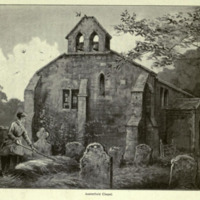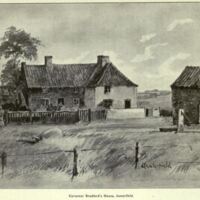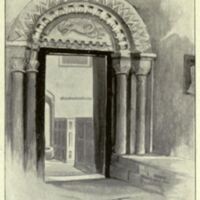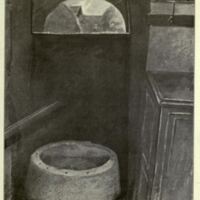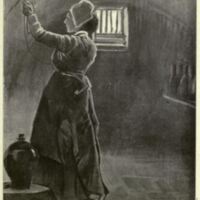Subject
Mackennel's travel writing takes him to Austerfield, Yorkshire, thought to be the childhood home of William Bradford. Bradford went on to become the second elected Governor of New Plymouth, Massachusetts a position he held for almost 30 years. Bradford was baptized in nearby St Helena's church: the building and the font is illustrated here by Charles Whymper. Bradford was one of the first signatories of the historic Mayflower Compact, but his most important contribution to the narrative of the Mayflower was his journal, ‘Of Plimoth Plantation’ which chronicled the early years of the colony. Its rediscovery and publication in 1856 was a landmark event in Mayflower history.
Mackennel shows his knowledge of British Mayflower history writing in his introduction to the Austerfield chapter by citing Bartlett, author of The Pilgrim Fathers, or, The Founders of New England in the Reign of James the First (1854) and Richard Monckton Milnes who composed the 1854 poem ‘Columbus and the Mayflower’. Also evident in this chapter is the imagination and conjecture so often employed by authors writing on the ‘Pilgrim Fathers’. Mackennel considers the people who may have frequent the cellar of Austerfield Manor long-ago in the seventeenth-century: ‘The imagination, unable to people this cellar with frightened people at their prayers, calls up another picture the notable housewife and her serving-maids’. This image, based on conjecture, is then illustrated for the reader by Whymper.
“FROM Gainsborough, in Lincolnshire, we have come to Scrooby, in Notts; a short walk of three or four miles more will take us to Austerfield, another little place lifted into notice by the story of man's piety and modest worth. We keep to the meadows as far as we can, and soon cross the River Idle into Yorkshire. We no longer tread the narrow northern road which once brought the horseman through Scrooby; we find ourselves on a broad highway, and under an avenue of fine elms we reach Bawtry. Going straight through the town, and dipping under the railway viaduct, in another two miles we arrive at Austerfield, of which Mr. Bartlett has given us the picture. 'A hamlet of the most humble description, simply a double row of rustic cottages, old-fashioned and mossy, but with their geraniums in the windows, and bright patches of flowers in the little gardens, displaying that neatness and instinctive rural taste peculiar to the better class of English husbandmen.'
Bawtry is a more important place than either Austerfield or Scrooby. It consists mainly of one street, ample enough to accommodate the weekly market, and the three annual fairs of wool and cheese and corn, to exercise horses and give room to deploy large flocks of sheep and herds of oxen. The width of the street confers no dignity on the small town; it rather dwarfs the houses on either side. Looking farther, you see signs of a modest prosperity ; ambition dies here, but one might have comfort as well as quiet in Bawtry. Richard Monckton Milnes made Bawtry Hall his home; it was a congenial resting-place for his particular literary turn, and here he wrote appreciative words of the Pilgrims and the Mayflower.
[…]
The chapel is very interesting. It is a small building, consisting only of a nave and chancel, separated from each other by a Norman arch. You enter from the south side ; before you there is a walled-up doorway, the upper part of which is now a large window, through which the gable corner of a farmhouse looks in upon you, and, when the barns are full, the top of a yellow haystack. Some beautiful old Gothic windows, and Norman work lately uncovered, are being carefully restored. The building is worth preservation for its antiquity ; it has undergone little change, no structural change, for centuries. Austerfield is a chapelry, dependent on the parish of Blythe. This is a good specimen of the smaller old ecclesiastical buildings, erected in a style as pure as that of the noblest parish church. The present font is modern; an old capacious vessel for water has been brought back into the chapel, and is shewn as the original font. Dr. Dexter found, in a yard in Austerfield, another old stone vessel, used for watering poultry, which has a primitive look. This was bought for America, and is now in a Congregational Church in Chicago. Which of these two vessels is the font in which Bradford was baptised, or if either of them were so, is a question to be decided by archaeologists, not by local makers of tradition.
At the upper end of the village stands a comfortable house, now divided into two cottages, lying open to the sun, and commanding a view of the farms around. You are told that this is 'the Bradford House.' The term is American rather than English; but Bradford's early home may have been here; this is such a. dwelling as a yeoman, in easy circumstances, would have lived in three hundred years ago. Persons who think of good architecture as referring to structure more than ornamentation will see excellence in the building. It is a two-storied Elizabethan house, of well-laid bricks, with sharply squared corners; the tiled roof is not deeply eaved, but sufficiently so to throw the rains off the walls. It has no trees about it; and being exposed to the sunshine and to every wind, it has no moss nor lichen growing on it; neither has any toad-flax nor stone-crop found a rooting-place between the bricks.
Entering by the left-hand door, you find yourself in the ' house-place,' or 'house,' as it is called in the midland counties. This was the living-room, with broad chimney and a large oven to the grate; overhead are the racks from which hams and game might hang ; on the wall above the fireplace, in Bradford's time, there would have been a brass blunderbuss among the bright pewter pots and platters. When the door is thrown wide open, as it mostly is in such a house, and the fire is burning briskly, the 'house-place' is the cheeriest, friendliest part of the dwelling; you need no parlour as you sit chatting in a room like this. The right-hand door probably served for the kitchen, unless it was added when the house was divided in two; it admits you to another large room, where the rougher work was done.
Across this room a flight of broad stone steps takes you into a small cellar, also admirably built. This you are told is 'the place where the Pilgrims used to worship, for fear of the persecutors.' It is very unlikely. The cellar is not a concealed room; the door is seen from the kitchen, and two windows, one on the steps leading to it, the other in the cellar itself, are pierced in the outside wall. The imagination, unable to people this cellar with frightened people at their prayers, calls up another picture the notable housewife and her serving-maids.”

